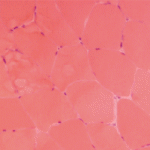CHICAGO—Immune mediated inflammatory myopathies represent a heterogenous group of diseases with variable degrees of multisystem involvement, including the skin, joints, lungs, and muscles. The ACR Convergence 2025 session, Management of Challenging Cases in Myositis, featured a case-based approach to highlight this complexity, guiding attendees through the nuances of diagnosis and management of antisynthetase syndrome, immune mediated necrotizing myopathy and dermatomyositis.
Decoding Antisynthetase Syndrome
The session opened with a presentation by Rohit Aggarwal, MD, professor of medicine at University of Pittsburg and co-director of the UPMC Myositis Center. Using two disparate cases, he illustrated the wide spectrum of clinical features in antisynthetase syndrome. The first patient was a 60-year-old woman with subacute onset of interstitial lung disease (ILD) and Raynaud’s, but notably had no rash, arthritis or muscle weakness, a negative anti-nuclear antibody (ANA) and only a modest elevation in muscle enzymes. The patient was found to have a cytoplasmic ANA, positive anti-Ro52 and anti-PL-7 antibodies. Dr. Aggarwal stressed the importance of identifying patients with ILD and minimal cutaneous or muscle disease, given that they too warrant immunosuppression and close monitoring.
He contrasted this case with that of a patient with classic proximal muscle and neck flexor weakness with marked elevation in CK, a seronegative rheumatoid arthritis-like pattern of synovitis, and mechanic’s hands. However the patient had no lung disease, rash, Raynaud’s or fever. Muscle biopsy demonstrated perivascular inflammation and antibody testing yielded positive ANA and anti-Jo-1 antibodies. He concluded the case by emphasizing that not every antisynthetase patient will have the classic triad of ILD, myositis and arthritis, and urged clinicians to consider antisynthetase syndrome when presented with seronegative rheumatoid arthritis.
Anti-Jo-1 is the most common antibody subtype in antisynthetase syndrome, seen in approximately 60% of cases. Other antisynthetase antibodies (e.g., PL-7, PL-12, OJ, EJ, KS) collectively account for the remaining 30–40% of cases, so it is important to test for these antibodies. Early identification and treatment may prevent development of more severe manifestations, such as ILD, which is the main contributor to mortality.1 Dr. Aggarwal also advocated for routine cardiac monitoring with echocardiograms in antisynthetase syndrome, analogous to standard practice in systemic sclerosis, given that pulmonary hypertension was a cause of mortality in 11% of patients in their cohort.
Presently there are no published classification criteria for antisynthetase syndrome, but Aggarwal and colleagues proposed a new set of criteria being reviewed by the ACR and EULAR. These criteria include points in both clinical and serologic domains, with ranges of scores representing probable and definitive antisynthetase syndrome. The criteria have been tested in multiple cohorts and have a high sensitivity and specificity. To demonstrate this point, both of the cases he presented, although phenotypically distinct, would meet the criteria for definitive antisynthetase syndrome.




